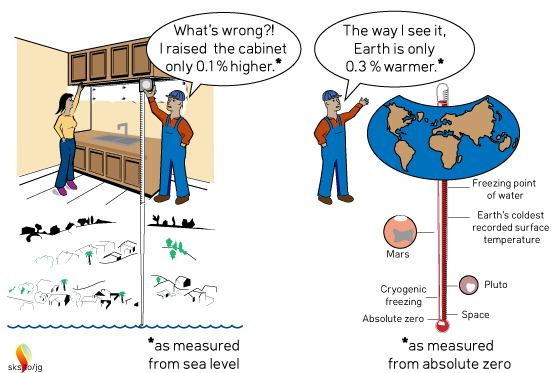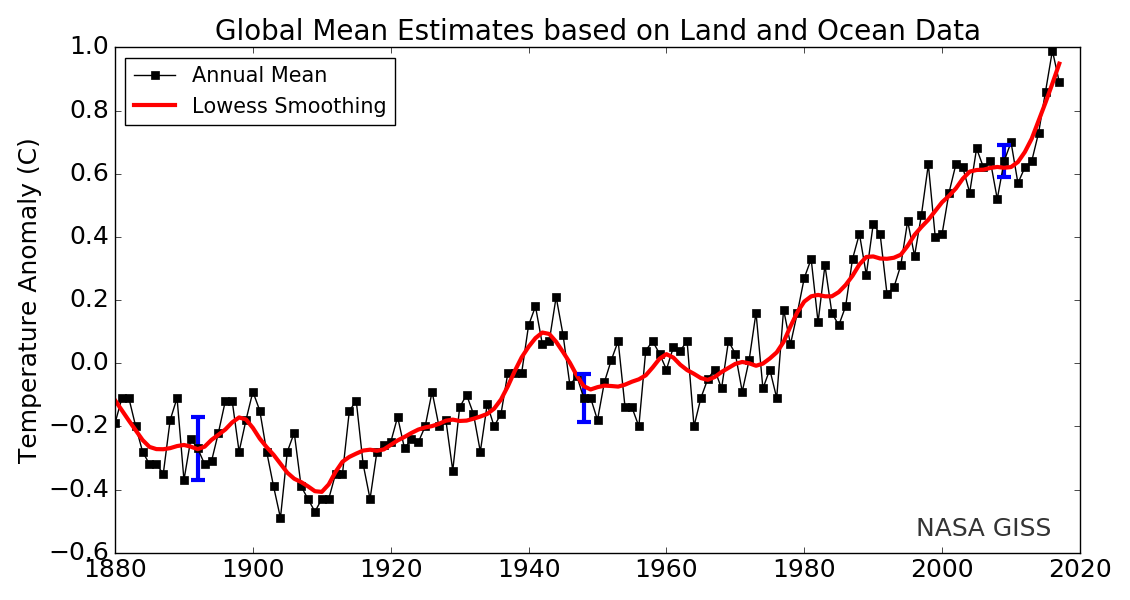Tag Line
The altitude of an airplane landing on a runway is only useful if measured relative to the ground, and not to sea level.
Elevator Statement
While determining the optimum height for kitchen cabinets, an industrious husband in Minnesota asks his wife
“Should we move the kitchen cabinets up by 0.1% from the position we originally discussed?”
“Why on earth are you bothering me about such a trivial amount?” came the reply. “Now if you were considering something ridiculous like raising them 1 ft. I would complain.”
In fact, the husband was considering raising the kitchen cabinets by 1 ft. His reference to 0.1% used the height above sea level of 1000 ft. as the reference point for making his measurements. A ridiculous analogy you say? Climate-change deniers and not-so-well-informed skeptics make similar errors, but they are not as obvious. Read on if you want to learn the error that a Nobel Laureate made by miscommunicating in a similar manner as this industrious husband.
Climate Science
Nobel Laureate Ivar Giaever stated the following in a talk he gave on climate science,1
“From ~1880 to 2013 temperature increased from ~288K to 288.8K (0.3%). If this is true, to me it means that the temperature has been amazingly stable.”
A 0.3% increase is kind of like the 0.1% the husband raised the kitchen cabinets. Dr. Giaever was using an absolute temperature scale for his comparison. Unlike the Celsius temperature scale where 0°C is the point where ice melts, 0K on the absolute temperature scale is the point where atoms “melt” and start moving. For comparison, on the temperature scale that Dr. Giaever was using, ice melts at a blisteringly hot 273K. If you live in a coastal city prone to flooding, do you care more about the temperature at which atoms “melt” and start moving (i.e., 0K), or do you care more about the temperature at which ice melts (i.e., 273K = 0°C) and continues moving ever closer to your home?

So why did Dr. Giaever choose to use as his reference point the temperature at which atoms “melt” instead of the more useful reference point where ice melts?
For measuring the height of kitchen cabinets the distance to the floor is the most logical and useful reference point.
For airplanes landing on runways, the distance to the ground is the most useful reference point for calculating altitude.
Considering that sea level is one of the most damaging aspects of global warming, the change of temperature relative to the melting point of ice is a more relevant reference point than the melting point of atoms. In this context, the temperature change has not been amazingly stable as Dr. Giaever stated, but in 2013 had already increased by a relatively large 5.3% (i.e., 0.8°C)2, and by now (i.e., 2018) has increased by an even larger 6.7% (i.e., 1°C warming)!
Noting that the main target of the Paris Accord is to keep warming to less than 2°C above pre-industrial global average temperature, that is a 13.3% increase with respect to the melting point of ice. Warming of 3°C3 represents a 20% increase!
Coming out of the last ice age Earth warmed about 5°C, which caused sea level to rise about 120 m (about 400 ft.).
Don’t let a Nobel laureate confuse you. Warming of 2 or 3°C within this century is a massive increase!
Footnotes
1. Click here for a description of misleading statements by Dr. Giaever, or click here to watch a video of his talk on global warming. Dr. Giaever's misleading quote about the temperature only changing by 0.3% is taken from a slide he used, which is shown starting at 6:06 in the video.
2. The temperature increases referred to here are relative to the temperature in 1880. Figure 1 shows the GISS (Goddard Institute for Space Studies) graph of temperature anomalies since 1880.
3. By some estimates, the INDCs (Intended Nationally Determined Contributions) associated with the Paris Accord would take us to nearly 3°C warming.
Graphics

Figure 1. GISS combined land-sea average temperature.
from Skeptical Science https://ift.tt/2jn1LHz
Tag Line
The altitude of an airplane landing on a runway is only useful if measured relative to the ground, and not to sea level.
Elevator Statement
While determining the optimum height for kitchen cabinets, an industrious husband in Minnesota asks his wife
“Should we move the kitchen cabinets up by 0.1% from the position we originally discussed?”
“Why on earth are you bothering me about such a trivial amount?” came the reply. “Now if you were considering something ridiculous like raising them 1 ft. I would complain.”
In fact, the husband was considering raising the kitchen cabinets by 1 ft. His reference to 0.1% used the height above sea level of 1000 ft. as the reference point for making his measurements. A ridiculous analogy you say? Climate-change deniers and not-so-well-informed skeptics make similar errors, but they are not as obvious. Read on if you want to learn the error that a Nobel Laureate made by miscommunicating in a similar manner as this industrious husband.
Climate Science
Nobel Laureate Ivar Giaever stated the following in a talk he gave on climate science,1
“From ~1880 to 2013 temperature increased from ~288K to 288.8K (0.3%). If this is true, to me it means that the temperature has been amazingly stable.”
A 0.3% increase is kind of like the 0.1% the husband raised the kitchen cabinets. Dr. Giaever was using an absolute temperature scale for his comparison. Unlike the Celsius temperature scale where 0°C is the point where ice melts, 0K on the absolute temperature scale is the point where atoms “melt” and start moving. For comparison, on the temperature scale that Dr. Giaever was using, ice melts at a blisteringly hot 273K. If you live in a coastal city prone to flooding, do you care more about the temperature at which atoms “melt” and start moving (i.e., 0K), or do you care more about the temperature at which ice melts (i.e., 273K = 0°C) and continues moving ever closer to your home?

So why did Dr. Giaever choose to use as his reference point the temperature at which atoms “melt” instead of the more useful reference point where ice melts?
For measuring the height of kitchen cabinets the distance to the floor is the most logical and useful reference point.
For airplanes landing on runways, the distance to the ground is the most useful reference point for calculating altitude.
Considering that sea level is one of the most damaging aspects of global warming, the change of temperature relative to the melting point of ice is a more relevant reference point than the melting point of atoms. In this context, the temperature change has not been amazingly stable as Dr. Giaever stated, but in 2013 had already increased by a relatively large 5.3% (i.e., 0.8°C)2, and by now (i.e., 2018) has increased by an even larger 6.7% (i.e., 1°C warming)!
Noting that the main target of the Paris Accord is to keep warming to less than 2°C above pre-industrial global average temperature, that is a 13.3% increase with respect to the melting point of ice. Warming of 3°C3 represents a 20% increase!
Coming out of the last ice age Earth warmed about 5°C, which caused sea level to rise about 120 m (about 400 ft.).
Don’t let a Nobel laureate confuse you. Warming of 2 or 3°C within this century is a massive increase!
Footnotes
1. Click here for a description of misleading statements by Dr. Giaever, or click here to watch a video of his talk on global warming. Dr. Giaever's misleading quote about the temperature only changing by 0.3% is taken from a slide he used, which is shown starting at 6:06 in the video.
2. The temperature increases referred to here are relative to the temperature in 1880. Figure 1 shows the GISS (Goddard Institute for Space Studies) graph of temperature anomalies since 1880.
3. By some estimates, the INDCs (Intended Nationally Determined Contributions) associated with the Paris Accord would take us to nearly 3°C warming.
Graphics

Figure 1. GISS combined land-sea average temperature.
from Skeptical Science https://ift.tt/2jn1LHz

Aucun commentaire:
Enregistrer un commentaire